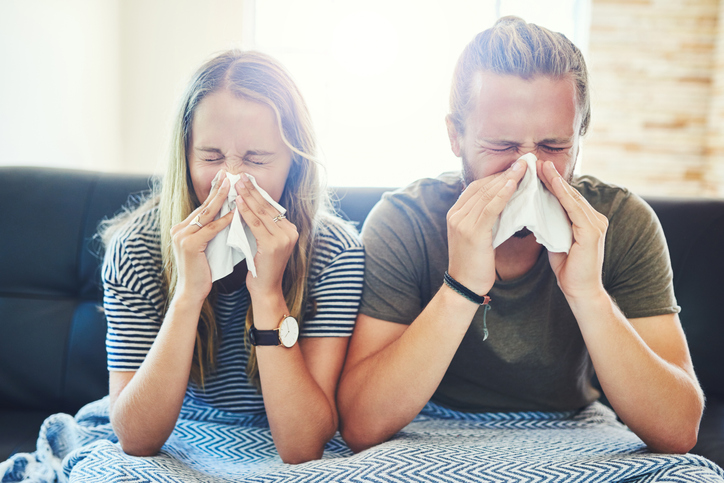Colorful flowers, outdoor activities and warming temperatures typify the season, but for allergy sufferers, congestion, itchy eyes and headaches seem more representative of spring.
“In Virginia, spring is the worst time of the year for most allergy sufferers,” explains Stephen Shield, M.D., a board-certified allergist with Allergy Partners of Eastern Virginia.
The spring allergy season can begin in mid-February and continue through midsummer occurring alongside perennial or year round allergens.
Although the season may be long for allergy sufferers, Shield and Ananth Thyagarajan, M.D., allergist-immunologist at Allergy Partners of Richmond, agree there are effective strategies for relieving allergy symptoms and eliminating allergen sensitivity.
Avoidance
Avoidance is an effective strategy in combating allergies; however, for most, complete avoidance of the allergen is impractical, Thyagarajan says. “You can’t live in a bubble for months out of the year.”
However, there are simple things you can do to limit your exposure to allergens.
If you suffer from spring allergies, avoid being outdoors between 5 a.m. and 9 a.m. when pollen is heaviest. When you come home from work, shower, wash your hair and change your clothes
to remove pollen particles, he says.
As the season continues, it requires less of the allergen to trigger an allergic reaction.
Those sensitized to seasonal and perennial allergens—dust, animal dander and mold—are more susceptible to allergic reactions when both types of allergens are present in the environment, he explains.
Keep your windows closed, your air conditioner on and your filters clean, Shield suggests. “Air conditioning filters the air and reduces indoor humidity, which reduces mold growth, but mostly keeps your house cool when the weather is warming up.” When working outdoors, gardening, cutting the grass or spring cleaning wear a mask, he says.
“Figure out what you are allergic to in the first place so you can avoid it,” Thyagarajan says.
Allergy pills and sprays can help relieve allergy symptoms.
Pills
The two most common form of allergy pills are antihistamines and leukotriene antagonists. Each works on a different pathway involved in the allergic reaction.
Allergists prescribe antihistamine tablets including Xyzal, Aterax and Clarinex more frequently for allergies than leukotriene antagonists, Thyagarajan says. Leukotriene antagonists like Singulair, Accolate and Zyflo are typically used in the treatment of allergic asthma and tend to be less effective in treating nasal and ocular allergy symptoms.
The most common over-the-counter allergy medications are Benadryl, Zyrtec, Claritin and Allegra—all antihistamines.
If you have mild symptoms, stock your medicine cabinet with over-the-counter allergy medications. For the most part, they are safe to try, Thyagarajan says.
Decongestants can also help treat allergy symptoms. Remember that generics can be just as effective as brand names and much more affordable, he says.
Sprays
Antihistamine and steroid prescription sprays can be effective treatment for allergic rhinitis—symptoms affecting the nose. Astelin, Astepro and Patanase are all examples of antihistamine sprays while Nasonex and Flonase are examples of steroid prescription sprays, Thyagarajan says. “Preliminary data shows when you use them in combination it is
very effective.”
Vasoconstrictor sprays like Afrin are another type of medicated spray that allergy sufferers purchase. These sprays work by constricting blood vessels to open nasal passages.
Thyagarajan does not recommend vasoconstrictors.
Although vasoconstrictors provide relief in the first few uses, they should not be used for more than three days. After that time, they cause rebound swelling, which can be worse than the initial symptoms.
The spring allergy season can begin in mid-February and continue through midsummer.”
Immunotherapy
The most effective treatment method is immunotherapy delivered through allergy shots. “Allergy shots work for 85 to 90 percent of the population,” Shield explains.
Shots alter the body’s response to allergens, building up immunity.
Made from natural proteins of a patient’s allergens, allergy shots work gradually as the medical provider increases doses over time.
It may take three to five years before the patient stops experiencing symptoms, Thyagarajan says.
Unlike any other treatment, shots have the ability to decrease symptoms significantly while preventing new allergies from forming. They can reduce the likelihood of people with chronic allergic rhinitis becoming asthmatic by 50 percent, Shield says.
Some allergy practices, including Allergy Partners, offer more than traditional immunotherapy options.
Allergy Partners offers cluster immunotherapy, through which allergists reduce the amount of time it takes to desensitize patients to allergy shots. Using this method, health care providers administer a higher dosage more frequently to build up the patient’s immunity faster.
It’s quickly become the preferred way for our patients to receive their allergy shots,” Shield said. “We’ve seen improvement in allergy symptoms in less than two months.”
Allergy Partners also offers sublingual immunotherapy (SLIT), a treatment that delivers protein abstracts through drops under the tongue.
SLIT has been offered in Europe for years but has only become available in the U.S. recently.
Allergy patients can self-administer SLIT at home. It is 70 percent as effective as allergy shots and presents a viable option for young children and adults with shot anxiety, Thyagarajan says.
Immunotherapy is not for everyone. It is important to consult an allergist when considering this treatment.
“There are plenty of good medications available, and if they don’t work, aren’t tolerated or if you just don’t want to take medications, then we can desensitize you in a short time and give you a lifetime of relief,” Shield says. “There’s no reason to suffer.”
Originally published in the Health Journal on 3-1-2013.



